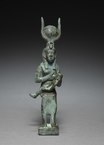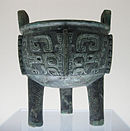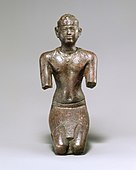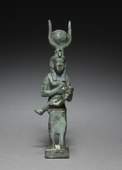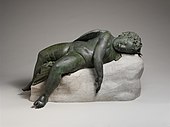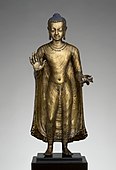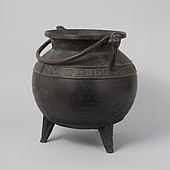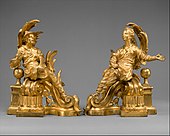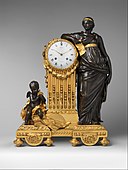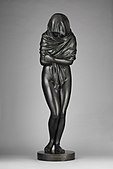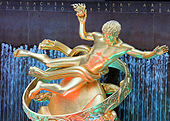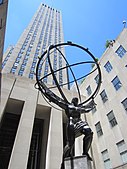Bronze
Bronze is an alloy consisting primarily of copper, commonly with about 12–12.5% tin and often with the addition of other metals (including aluminium, manganese, nickel, or zinc) and sometimes non-metals, such as phosphorus, or metalloids, such as arsenic or silicon. These additions produce a range of alloys that may be harder than copper alone, or have other useful properties, such as strength, ductility, or machinability.
The archaeological period in which bronze was the hardest metal in widespread use is known as the Bronze Age. The beginning of the Bronze Age in western Eurasia and India is conventionally dated to the mid-4th millennium BC (~3500 BC), and to the early 2nd millennium BC in China;[1] elsewhere it gradually spread across regions. The Bronze Age was followed by the Iron Age starting about 1300 BC and reaching most of Eurasia by about 500 BC, although bronze continued to be much more widely used than it is in modern times.
Because historical artworks were often made of brasses (copper and zinc) and bronzes of different metallic compositions, modern museum and scholarly descriptions of older artworks increasingly use the generalized term "copper alloy" instead of the names of individual alloys. This is done (at least in part) to prevent database searches from failing merely because of errors or disagreements in the naming of historic copper alloys.[2]
Etymology
[edit]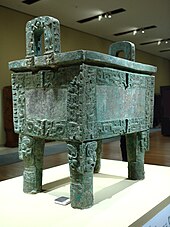
The word bronze (1730–1740) is borrowed from Middle French bronze (1511), itself borrowed from Italian bronzo 'bell metal, brass' (13th century, transcribed in Medieval Latin as bronzium) from either:
- bróntion, back-formation from Byzantine Greek brontēsíon (βροντησίον, 11th century), perhaps from Brentḗsion (Βρεντήσιον, 'Brindisi'), reputed for its bronze;[3][4] or originally:
- in its earliest form from Old Persian birinj, (برنج, 'brass', modern berenj) and piring (پرنگ) 'copper',[5] from which also came Georgian brinǯi (ბრინჯი), Turkish pirinç from "bir" (one) "birinç" (primary), and Armenian brinj (բրինձ), also meaning 'bronze'.
History
[edit]
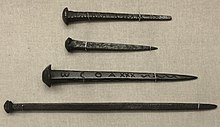
The discovery of bronze enabled people to create metal objects that were harder and more durable than previously possible. Bronze tools, weapons, armor, and building materials such as decorative tiles were harder and more durable than their stone and copper ("Chalcolithic") predecessors. Initially, bronze was made out of copper and arsenic or from naturally or artificially mixed ores of those metals, forming arsenic bronze.[6]
The earliest known arsenic-copper-alloy artifacts come from a Yahya Culture (Period V 3800-3400 BCE) site, at Tal-i-Iblis on the Iranian plateau, and were smelted from native arsenical copper and copper-arsenides, such as algodonite and domeykite.[7][8]
The earliest tin-copper-alloy artifact has been dated to c. 4650 BC, in a Vinča culture site in Pločnik (Serbia), and believed to have been smelted from a natural tin-copper ore, stannite.[9]
Other early examples date to the late 4th millennium BC[broken anchor] in Egypt, Susa (Iran) and some ancient sites in China, Luristan (Iran), Tepe Sialk (Iran), Mundigak (Afghanistan), and Mesopotamia (Iraq).[7][10]
Tin bronze was superior to arsenic bronze in that the alloying process could be more easily controlled, and the resulting alloy was stronger and easier to cast. Also, unlike those of arsenic, metallic tin and the fumes from tin refining are not toxic.
Tin became the major non-copper ingredient of bronze in the late 3rd millennium BC.[11] Ores of copper and the far rarer tin are not often found together (exceptions include Cornwall in the United Kingdom, one ancient site in Thailand and one in Iran), so serious bronze work has always involved trade with other regions. Tin sources and trade in ancient times had a major influence on the development of cultures. In Europe, a major source of tin was the British deposits of ore in Cornwall, which were traded as far as Phoenicia in the eastern Mediterranean. In many parts of the world, large hoards of bronze artifacts are found, suggesting that bronze also represented a store of value and an indicator of social status. In Europe, large hoards of bronze tools, typically socketed axes (illustrated above), are found, which mostly show no signs of wear. With Chinese ritual bronzes, which are documented in the inscriptions they carry and from other sources, the case is clear. These were made in enormous quantities for elite burials, and also used by the living for ritual offerings.
Transition to iron
[edit]Though bronze is generally harder than wrought iron, with Vickers hardness of 60–258 vs. 30–80,[12] the Bronze Age gave way to the Iron Age after a serious disruption of the tin trade: the population migrations of around 1200–1100 BC reduced the shipping of tin around the Mediterranean and from Britain, limiting supplies and raising prices.[13] As the art of working in iron improved, iron became cheaper and improved in quality. As later cultures advanced from hand-wrought iron to machine-forged iron (typically made with trip hammers powered by water), blacksmiths also learned how to make steel. Steel is stronger and harder than bronze and holds a sharper edge longer.[14] Bronze was still used during the Iron Age, and has continued in use for many purposes to the modern day.
Composition
[edit]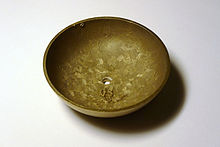
There are many different bronze alloys, but typically modern bronze is 88% copper and 12% tin.[15] Alpha bronze consists of the alpha solid solution of tin in copper. Alpha bronze alloys of 4–5% tin are used to make coins, springs, turbines and blades. Historical "bronzes" are highly variable in composition, as most metalworkers probably used whatever scrap was on hand; the metal of the 12th-century English Gloucester Candlestick is bronze containing a mixture of copper, zinc, tin, lead, nickel, iron, antimony, arsenic and an unusually large amount of silver – between 22.5% in the base and 5.76% in the pan below the candle. The proportions of this mixture suggest that the candlestick was made from a hoard of old coins. The 13th-century Benin Bronzes are in fact brass, and the 12th-century Romanesque Baptismal font at St Bartholomew's Church, Liège is sometimes described as bronze and sometimes as brass.
In the Bronze Age, two forms of bronze were commonly used: "classic bronze", about 10% tin, was used in casting; and "mild bronze", about 6% tin, was hammered from ingots to make sheets. Bladed weapons were mostly cast from classic bronze, while helmets and armor were hammered from mild bronze.
Modern commercial bronze (90% copper and 10% zinc) and architectural bronze (57% copper, 3% lead, 40% zinc) are more properly regarded as brass alloys because they contain zinc as the main alloying ingredient. They are commonly used in architectural applications.[16][17] Plastic bronze contains a significant quantity of lead, which makes for improved plasticity,[18] and was possibly used by the ancient Greeks in ship construction.[19] Silicon bronze has a composition of Si: 2.80–3.80%, Mn: 0.50–1.30%, Fe: 0.80% max., Zn: 1.50% max., Pb: 0.05% max., Cu: balance.[20] Other bronze alloys include aluminium bronze, phosphor bronze, manganese bronze, bell metal, arsenical bronze, speculum metal, bismuth bronze, and cymbal alloys.
Properties
[edit]Copper-based alloys have lower melting points than steel or iron and are more readily produced from their constituent metals. They are generally about 10 percent denser than steel, although alloys using aluminum or silicon may be slightly less dense. Bronze is a better conductor of heat and electricity than most steels. The cost of copper-base alloys is generally higher than that of steels but lower than that of nickel-base alloys.
Bronzes are typically ductile alloys, considerably less brittle than cast iron. Copper and its alloys have a huge variety of uses that reflect their versatile physical, mechanical, and chemical properties. Some common examples are the high electrical conductivity of pure copper, low-friction properties of bearing bronze (bronze that has a high lead content— 6–8%), resonant qualities of bell bronze (20% tin, 80% copper), and resistance to corrosion by seawater of several bronze alloys.
The melting point of bronze varies depending on the ratio of the alloy components and is about 950 °C (1,742 °F). Bronze is usually nonmagnetic, but certain alloys containing iron or nickel may have magnetic properties. Typically bronze oxidizes only superficially; once a copper oxide (eventually becoming copper carbonate) layer is formed, the underlying metal is protected from further corrosion. This can be seen on statues from the Hellenistic period. If copper chlorides are formed, a corrosion-mode called "bronze disease" will eventually completely destroy it.[21]
Uses
[edit]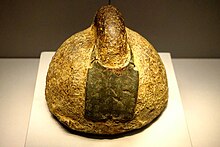

Bronze, or bronze-like alloys and mixtures, were used for coins over a longer period. Bronze was especially suitable for use in boat and ship fittings prior to the wide employment of stainless steel owing to its combination of toughness and resistance to salt water corrosion. Bronze is still commonly used in ship propellers and submerged bearings. In the 20th century, silicon was introduced as the primary alloying element, creating an alloy with wide application in industry and the major form used in contemporary statuary. Sculptors may prefer silicon bronze because of the ready availability of silicon bronze brazing rod, which allows color-matched repair of defects in castings. Aluminum is also used for the structural metal aluminum bronze. Bronze parts are tough and typically used for bearings, clips, electrical connectors and springs.
Bronze also has low friction against dissimilar metals, making it important for cannons prior to modern tolerancing, where iron cannonballs would otherwise stick in the barrel.[22] It is still widely used today for springs, bearings, bushings, automobile transmission pilot bearings, and similar fittings, and is particularly common in the bearings of small electric motors. Phosphor bronze is particularly suited to precision-grade bearings and springs. It is also used in guitar and piano strings. Unlike steel, bronze struck against a hard surface will not generate sparks, so it (along with beryllium copper) is used to make hammers, mallets, wrenches and other durable tools to be used in explosive atmospheres or in the presence of flammable vapors. Bronze is used to make bronze wool for woodworking applications where steel wool would discolor oak. Phosphor bronze is used for ships' propellers, musical instruments, and electrical contacts.[23] Bearings are often made of bronze for its friction properties. It can be impregnated with oil to make the proprietary Oilite and similar material for bearings. Aluminum bronze is hard and wear-resistant, and is used for bearings and machine tool ways.[24] The Doehler Die Casting Co. of Toledo, Ohio were known for the production of Brastil, a high tensile corrosion resistant bronze alloy.[25][26]
Architectural bronze
[edit]
The Seagram Building on New York City's Park Avenue is the "iconic glass box sheathed in bronze, designed by Mies van der Rohe."[27] The Seagram Building was the first time that an entire building was sheathed in bronze.[28] The General Bronze Corporation fabricated 3,200,000 pounds (1,600 tons) of bronze at its plant in Garden City, New York.[28] The Seagram Building is a 38-story, 516-foot bronze-and-topaz-tinted glass building.[27] The building looks like a "squarish 38-story tower clad in a restrained curtain wall of metal and glass."[29] "Bronze was selected because of its color, both before and after aging, its corrosion resistance, and its extrusion properties.[28][27] In 1958, it was not only the most expensive building of its time — $36 million — but it was the first building in the world with floor-to-ceiling glass walls.[27] Mies van der Rohe achieved the crisp edges that were custom-made with specific detailing by General Bronze[28] and "even the screws that hold in the fixed glass-plate windows were made of brass."[27]
Sculptures
[edit]Bronze is widely used for casting bronze sculptures. Common bronze alloys have the unusual and desirable property of expanding slightly just before they set, thus filling the finest details of a mould. Then, as the bronze cools, it shrinks a little, making it easier to separate from the mould.[30] The Assyrian king Sennacherib (704–681 BC) claims to have been the first to cast monumental bronze statues (of up to 30 tonnes) using two-part moulds instead of the lost-wax method.[31]
Bronze statues were regarded as the highest form of sculpture in Ancient Greek art, though survivals are few, as bronze was a valuable material in short supply in the Late Antique and medieval periods. Many of the most famous Greek bronze sculptures are known through Roman copies in marble, which were more likely to survive. In India, bronze sculptures from the Kushana (Chausa hoard) and Gupta periods (Brahma from Mirpur-Khas, Akota Hoard, Sultanganj Buddha) and later periods (Hansi Hoard) have been found.[32] Indian Hindu artisans from the period of the Chola empire in Tamil Nadu used bronze to create intricate statues via the lost-wax casting method with ornate detailing depicting the deities of Hinduism. The art form survives to this day, with many silpis, craftsmen, working in the areas of Swamimalai and Chennai.
In antiquity other cultures also produced works of high art using bronze. For example: in Africa, the bronze heads of the Kingdom of Benin; in Europe, Grecian bronzes typically of figures from Greek mythology; in east Asia, Chinese ritual bronzes of the Shang and Zhou dynasty—more often ceremonial vessels but including some figurine examples. Bronze continues into modern times as one of the materials of choice for monumental statuary.
-
The Dancing Girl, an Harappan artwork; 2400–1900 BC; bronze; height: 10.8 cm; National Museum (New Delhi, India)
-
Ritual tripod cauldron (ding); c. 13th century BC; bronze: height with handles: 25.4 cm; Metropolitan Museum of Art (New York City)
-
Ancient Egyptian statuette of a Kushite pharaoh; 713–664 BC; bronze, precious-metal leaf; height: 7.6 cm, width: 3.2 cm, depth: 3.6 cm; Metropolitan Museum of Art
-
Etruscan tripod base for a thymiaterion (incense burner); 475-450 BC; bronze; height: 11 cm; Metropolitan Museum of Art
-
Ancient Egyptian statuette of Isis and Horus; 305–30 BC; solid cast of bronze; 4.8 × 10.3 cm; Cleveland Museum of Art (Cleveland, Ohio, US)
-
Ancient Greek statue of Eros sleeping; 3rd–2nd century BC; bronze; 41.9 × 35.6 × 85.2 cm; Metropolitan Museum of Art
-
Krishna with his consorts Rukmini and Satyabhama and his mount Garuda, Tamil Nadu, India, late 11th–12th century
-
French or South Netherlandish Medieval caldron; 13th or 14th century; bronze and wrought iron; height: 37.5 cm, diameter: 34.3 cm; Metropolitan Museum of Art
-
Pair of French Rococo firedogs (chenets); c. 1750; gilt bronze; dimensions of the first: 52.7 x 48.3 x 26.7 cm, of the second: 45.1 x 49.1 x 24.8 cm; Metropolitan Museum of Art
-
French Neoclassical mantel clock (pendule de cheminée); 1757–1760; gilded and patinated bronze, oak veneered with ebony, white enamel with black numerals, and other materials; 48.3 × 69.9 × 27.9 cm; Metropolitan Museum of Art
-
Pair of French Chinoiserie firedogs; 1760–1770; gilt bronze; height (each): 41.9 cm; Metropolitan Museum of Art
-
Pair of Chinese vases with French Rococo mounts; the vases: early 18th century, the mounts: 1760–70; hard-paste porcelain with gilt-bronze mounts; 32.4 x 16.5 x 12.4 cm; Metropolitan Museum of Art
-
French Neoclassical mantel clock ("Pendule Uranie"); 1764–1770; case: patinated bronze and gilded bronze, Dial: white enamel, movement: brass and steel; 71.1 × 52.1 × 26.7 cm; Metropolitan Museum of Art
-
Pair of mounted vases (vase à monter); 1765–70; soft-paste porcelain and French gilt bronze; 28.9 x 17.1 cm; Metropolitan Museum of Art
-
Winter; by Jean-Antoine Houdon; 1787; bronze; 143.5 x 39.1 x 50.5 cm, height of the pedestal: 86.4 cm; Metropolitan Museum of Art
Lamps
[edit]Tiffany Glass Studios, made famous by Louis C. Tiffany commonly referred to his product as favrile glass or "Tiffany glass," and used bronze in their artisan work for his Tiffany lamps.[33][34][35][36]

Fountains and doors
[edit]
The largest and most ornate bronze fountain known to be cast in the world was by the Roman Bronze Works and General Bronze Corporation in 1952. The material used for the fountain, known as statuary bronze, is a quaternary alloy made of copper, zinc, tin, and lead, and traditionally golden brown in color. This was made for the Andrew W. Mellon Memorial Fountain in Federal Triangle in Washington, DC.[37] Another example of the massive, ornate design projects of bronze, and attributed to General Bronze/Roman Bronze Works were the massive bronze doors to the United States Supreme Court Building in Washington, DC.[38]
Mirrors
[edit]
Before it became possible to produce glass with acceptably flat surfaces, bronze was a standard material for mirrors. Bronze was used for this purpose in many parts of the world, probably based on independent discoveries. Bronze mirrors survive from the Egyptian Middle Kingdom (2040–1750 BC), and China from at least c. 550 BC. In Europe, the Etruscans were making bronze mirrors in the sixth century BC, and Greek and Roman mirrors followed the same pattern. Although other materials such as speculum metal had come into use, and Western glass mirrors had largely taken over, bronze mirrors were still being made in Japan and elsewhere in the eighteenth century, and are still made on a small scale in Kerala, India.
Musical instruments
[edit]

Bronze is the preferred metal for bells in the form of a high tin bronze alloy known as bell metal, which is typically about 23% tin.
Nearly all professional cymbals are made from bronze, which gives a desirable balance of durability and timbre. Several types of bronze are used, commonly B20 bronze, which is roughly 20% tin, 80% copper, with traces of silver, or the tougher B8 bronze made from 8% tin and 92% copper. As the tin content in a bell or cymbal rises, the timbre drops.[39]
Bronze is also used for the windings of steel and nylon strings of various stringed instruments such as the double bass, piano, harpsichord, and guitar. Bronze strings are commonly reserved on pianoforte for the lower pitch tones, as they possess a superior sustain quality to that of high-tensile steel.[40]
Bronzes of various metallurgical properties are widely used in struck idiophones around the world, notably bells, singing bowls, gongs, cymbals, and other idiophones from Asia. Examples include Tibetan singing bowls, temple bells of many sizes and shapes, Javanese gamelan, and other bronze musical instruments. The earliest bronze archeological finds in Indonesia date from 1–2 BC, including flat plates probably suspended and struck by a wooden or bone mallet.[40][41] Ancient bronze drums from Thailand and Vietnam date back 2,000 years. Bronze bells from Thailand and Cambodia date back to 3600 BC.
Some companies are now making saxophones from phosphor bronze (3.5 to 10% tin and up to 1% phosphorus content).[42] Bell bronze/B20 is used to make the tone rings of many professional model banjos.[43] The tone ring is a heavy (usually 3 lb; 1.4 kg) folded or arched metal ring attached to a thick wood rim, over which a skin, or most often, a plastic membrane (or head) is stretched – it is the bell bronze that gives the banjo a crisp powerful lower register and clear bell-like treble register.[44]
Coins and medals
[edit]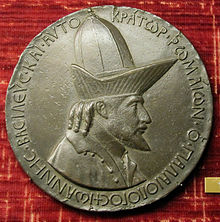
Bronze has also been used in coins; most "copper" coins are actually bronze, with about 4 percent tin and 1 percent zinc.[45]
As with coins, bronze has been used in the manufacture of various types of medals for centuries, and "bronze medals" are known in contemporary times for being awarded for third place in sporting competitions and other events. The term is now often used for third place even when no actual bronze medal is awarded. The usage in part arose from the trio of gold, silver and bronze to represent the first three Ages of Man in Greek mythology: the Golden Age, when men lived among the gods; the Silver age, where youth lasted a hundred years; and the Bronze Age, the era of heroes. It was first adopted for a sports event at the 1904 Summer Olympics. At the 1896 event, silver was awarded to winners and bronze to runners-up, while at 1900 other prizes were given rather than medals.
Bronze is the normal material for the related form of the plaquette, normally a rectangular work of art with a scene in relief, for a collectors' market.
Bronze is also associated with eighth wedding anniversaries.
Biblical references
[edit]There are over 125 references to bronze ('nehoshet'), which appears to be the Hebrew word used for copper and any of its alloys. However, the Old Testament era Hebrews are not thought to have had the capability to manufacture zinc (needed to make brass) and so it is likely that 'nehoshet' refers to copper and its alloys with tin, now called bronze.[46] In the King James Version, there is no use of the word 'bronze' and 'nehoshet' was translated as 'brass'. Modern translations use 'bronze'. Bronze (nehoshet) was used widely in the Tabernacle for items such as the bronze altar (Exodus Ch.27), bronze laver (Exodus Ch.30), utensils, and mirror (Exodus Ch.38). It was mentioned in the account of Moses holding up a bronze snake on a pole in Numbers Ch.21. In First Kings, it is mentioned that Hiram was very skilled in working with bronze, and he made many furnishings for Solomon's Temple including pillars, capitals, stands, wheels, bowls, and plates, some of which were highly decorative (see I Kings 7:13-47). Bronze was also widely used as battle armor and helmet, as in the battle of David and Goliath in I Samuel 17:5-6;38 (also see II Chron. 12:10).
See also
[edit]- Art object
- Bell founding
- Bronze and brass ornamental work
- Bronzing
- Chinese bronze inscriptions
- Dezincification resistant brass
- French Empire mantel clock
- List of copper alloys
- Ormolu
- Seagram Building, the first office building in the world to use extruded bronze on a facade
- General Bronze Corporation
- Tiffany lamp
- UNS C69100 (Tungum), a bronze alloy of copper, aluminium, nickel, tin, and zinc
- Yoruba art
ปิดการใช้งาน
References
[edit]- ^ Thorp, Robert L. (2013). China in the Early Bronze Age: Shang Civilization. University of Pennsylvania Press.[page needed]
- ^ "British Museum, "Scope Note" for "copper alloy"". British Museum. Archived from the original on 18 August 2014. Retrieved 14 September 2014.
- ^ Kahane, Henry; Kahane, Renée (1981). "Byzantium's Impact on the West: The Linguistic Evidence". Illinois Classical Studies. 6 (2): 395. JSTOR 23062525.
- ^ Originally Berthelot, M.P.E. (1888). "Sur le nom du bronze chez les alchimistes grecs". Revue archéologique (in French): 294–98.
- ^ Originally Lokotsch, Karl (1927). Etymologisches Wörterbuch der europäischen Wörter orientalischen Ursprungs (in German). Heidelberg: Carl Winter's Universitätsbuchhandlung. p. 1657.
- ^ Tylecote, R.F. (1992). A History of Metallurgy, Second Edition. London: Maney Publishing, for the Institute of Materials. ISBN 978-1-902653-79-2. Archived from the original on 2015-04-02.
- ^ a b Thornton, C.; Lamberg-Karlovsky, C.C.; Liezers, M.; Young, S.M.M. (2002). "On pins and needles: tracing the evolution of copper-based alloying at Tepe Yahya, Iran, via ICP-MS analysis of Common-place items". Journal of Archaeological Science. 29 (12): 1451–60. Bibcode:2002JArSc..29.1451T. doi:10.1006/jasc.2002.0809.
- ^ "Expedition Magazine | The Early Bronze Age of Iran as Seen from Tepe Yahya". Expedition Magazine. Retrieved 2024-04-24.
- ^ Radivojević, Miljana; Rehren, Thilo (December 2013). "Tainted ores and the rise of tin bronzes in Eurasia, c. 6500 years ago". Antiquity Publications Ltd. Archived from the original on 2014-02-05.
- ^ Potts, Daniel T. (1997). Mesopotamian Civilization: The Material Foundations. London: Athlone Press. p. 169. ISBN 978-0-48593-001-6.
- ^ Kaufman, Brett. "Metallurgy and Ecological Change in the Ancient Near East" (PDF). Backdirt: Annual Review. 2011: 86.
- ^ Smithells Metals Reference Book, 8th Edition, ch. 22
- ^ Cramer, Clayton E. (10 December 1995). "What Caused The Iron Age?" (PDF). claytoncramer.com. Archived from the original (PDF) on 2010-12-28.
- ^ Sherby, O. D.; Wadsworth, J. (2000). "Ancient Blacksmiths, the Iron Age, Damascus Steels, and Modern Metallurgy" (PDF). Thermec 2000. Las Vegas, Nevada: U.S. Department of Commerce. Archived from the original (PDF) on 2007-06-26. Retrieved 24 August 2022.
- ^ Knapp, Brian. (1996) Copper, Silver and Gold. Reed Library, Australia.
- ^ "Copper alloys". Archived from the original on 11 September 2013. Retrieved 14 September 2014.
- ^ "CDA UNS Standard Designations for Wrought and Cast Copper and Copper Alloys: Introduction". Archived from the original on 24 September 2013. Retrieved 14 September 2014.
- ^ "plastic bronze". The Free Encyclopedia. Retrieved 24 August 2022.
- ^ Adams, Jonathan R. (2012). "The Belgammel Ram, a Hellenistic-Roman BronzeProembolionFound off the Coast of Libya: test analysis of function, date and metallurgy, with a digital reference archive" (PDF). International Journal of Nautical Archaeology. 42 (1): 60–75. CiteSeerX 10.1.1.738.4024. doi:10.1111/1095-9270.12001. S2CID 39339094. Archived (PDF) from the original on 2016-08-28.
- ^ ASTM B124 / B124M – 15. ASTM International. 2015.
- ^ "Bronze Disease, Archaeologies of the Greek Past". The Joukowsky Institute for Archaeology Classroom. Archived from the original on 26 February 2015. Retrieved 14 September 2014.
- ^ Alavudeen, A.; Venkateshwaran, N.; Winowlin Jappes, J. T. (1 January 2006). A Textbook of Engineering Materials and Metallurgy. Firewall Media. pp. 136–. ISBN 978-81-7008-957-5. Archived from the original on 10 June 2016. Retrieved 25 June 2013.
- ^ "Resources: Standards & Properties – Copper & Copper Alloy Microstructures: Phosphor Bronze". Copper Development Association Inc. Archived from the original on 2015-12-08. Retrieved 24 August 2022.
- ^ "Resources: Standards & Properties – Copper & Copper Alloy Microstructures: Aluminum Bronzes". Copper Development Association Inc. Archived from the original on 2013-12-05. Retrieved 24 August 2022.
- ^ "Doehler-Jarvis Company Collection, MSS-202".
- ^ Woldman’s Engineering Alloys, 9th Edition 1936, American Society for Metals, ISBN 978-0-87170-691-1
- ^ a b c d e Nash, Eric (1999). Manhattan Skyscrapers (1st ed.). Princeton, New Jersey: Princeton Architectural Press. pp. 105–106. ISBN 1-56898-181-3. Retrieved 16 December 2023.
- ^ a b c d Ennis, Thomas. "Building is Designer's Testament" (PDF). The New York Times. No. November 10, 1957. pp. 313, 320. Retrieved 17 December 2023.
Seagram Building Marks Apex Of Mies van der Rohe's Career
- ^ "SEAGRAM'S PLANS PLAZA TOWER IN NEW YORK and Mies van der Rohe designs his first skyscraper office building" (PDF). Architectural Forum. 102 (4): 9. April 1955. Retrieved 21 December 2023.
- ^ Savage, George (1968). A Concise History of Bronzes. New York: Frederick A. Praeger, Inc. Publishers. p. 17.
- ^ for a translation of his inscription see the appendix in Dalley, Stephanie (2013). The Mystery of the Hanging Garden of Babylon: an elusive World Wonder traced. OUP. ISBN 978-0-19-966226-5.
- ^ Indian bronze masterpieces: the great tradition: specially published for the Festival of India, Asharani Mathur, Sonya Singh, Festival of India, Brijbasi Printers, Dec 1, 1988
- ^ "Tiffany Studios". The Charles Hosmer Morse Museum of American Art. Retrieved 17 December 2023.
- ^ Eidelberg, Martin; McClelland, Nany (2001). Behind the Scenes of Tiffany Glassmaking: the Nash Notebooks (1st ed.). St. Martin's Press. pp. 2–10. ISBN 9780312282653.
- ^ "A Chronology of Louis C. Tiffany and Tiffany Studios". Tiffany Studios. Retrieved 17 December 2023.
- ^ "Roman Bronze Works". Amon Carter Museum of American Art. Carter Museum. Retrieved 23 December 2023.
- ^ "Andrew W. Mellon Memorial Fountain Restored by National Gallery of Art in Honor of 75th Anniversary with a Major Grant from Richard King Mellon Foundation —Monumental Bronze Fountain Operational on March 17—". National Gallery of Art. Washington, DC. Retrieved 23 December 2023.
Andrew W. Mellon Memorial Fountain, situated at the apex of the Federal Triangle complex in downtown Washington, DC
- ^ "The Bronze Doors" (PDF). Supreme Court. Washington, DC: The Supreme Court. Retrieved 23 December 2023.
"Out of all of our monumental projects, spread over two lifetimes, the Supreme Court doors are the only work that we ever signed – that's how important they were." – JOHN DONNELLY, JR., Sculptor
- ^ Von Falkenhausen, Lothar (1993). Suspended Music: Chime-Bells in the Culture of Bronze Age China. Berkeley and Los Angeles: University of California Press. p. 106. ISBN 978-0-520-07378-4. Archived from the original on 2016-05-26.
- ^ a b McCreight, Tim (1992). Metals technic: a collection of techniques for metalsmiths. Brynmorgen Press. ISBN 0-9615984-3-3.[page needed]
- ^ LaPlantz, David (1991). Jewelry – Metalwork 1991 Survey: Visions – Concepts – Communication. S. LaPlantz. ISBN 0-942002-05-9.[page needed]
- ^ "www.sax.co.uk". Archived from the original on 11 August 2014. Retrieved 18 September 2014.
- ^ Siminoff, Roger H. (2008). Siminoff's Luthiers Glossary. New York: Hal Leonard. p. 13. ISBN 9781423442929.
- ^ "What Is Bronze? | National Bell Festival". www.bells.org. Retrieved 2024-07-04.
- ^ "bronze | alloy". Encyclopædia Britannica (Online ed.). Archived from the original on 2016-07-30. Retrieved 2016-07-21.
- ^ Meschel, Susan V. (2 October 2017). "Nehoshet: Copper, Bronze or Brass? Which are Plausible in the Tanakh?". Jewish Bible Quarterly. Retrieved 24 August 2022.
External links
[edit]- Bronze bells (archived 16 December 2006)
- "Lost Wax, Found Bronze": lost-wax casting explained (archived 23 May 2009)
- "Flash animation of the lost-wax casting process". James Peniston Sculpture. Retrieved 2008-11-03.
- Viking Bronze – Ancient and Early Medieval bronze casting (archived 16 April 2016)


